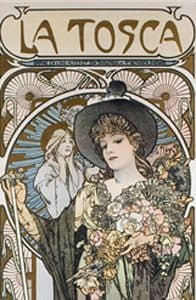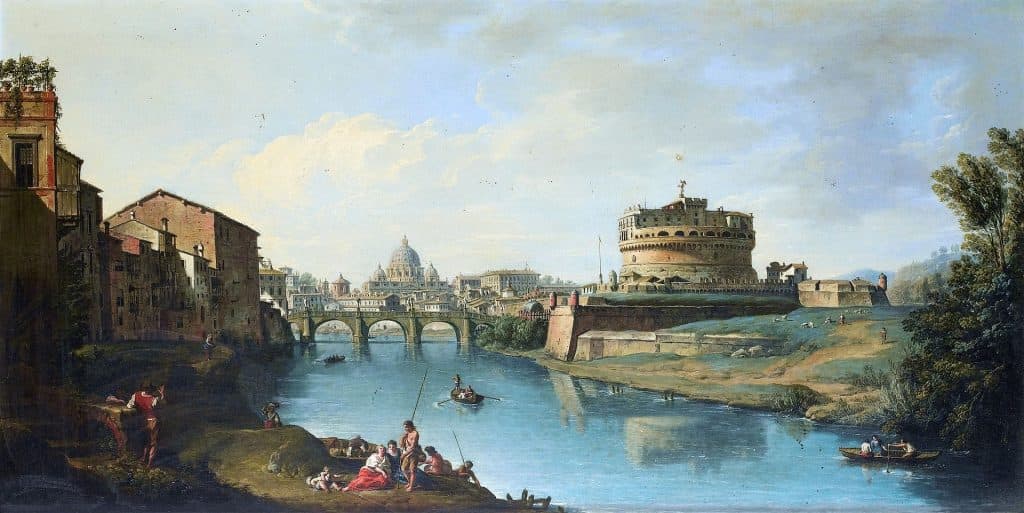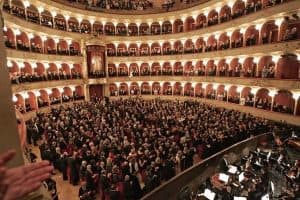The Making of Tosca
TOSCA: RECIPE FOR SUCCESS.
Too many cooks—at least five—were involved in the libretto of Puccini’s first great operatic success Manon Lescaut. For La Bohème the cooks were reduced to two: Giuseppe Giacosa and Luigi Illica, but Henry Mürger’s original ingredients (a novel and its stage adaptation) proved difficult to mix to the Master Chef’s (Puccini) satisfaction. Tosca was an easier dish to prepare (though it had its problems), possibly because its base had already been made for some years before Puccini could use it. And what a meal the Master Chef gave us!
Ferdinando Fontana, Puccini’s librettist for his first two operas, Le Villi and Edgar, suggested Sardou’s play La Tosca as their next collaboration. They had both seen Bernhardt play the role in Turin and Milan. Puccini was sufficiently intrigued, in 1889, to urge his publisher, Giulio Ricordi, to see about getting the rights from the playwright: “I can see the drama that I need” – nothing spectacular which would demand a huge amount of music. Emanuele Muzio, a close friend and colleague of Giuseppe Verdi, was living and working in Paris at the time; Ricordi asked him to investigate the possibility of this French patissier assigning the musical rights of his recipe to Puccini. Sardou, offended by Italian reviews of his play, hoped a French composer might consider it, but was not averse to knowing how much cash Puccini would pay and what his percentage might be from performances of the resulting opera. Other, and better-known, Italian composers, he claimed, were interested in La Tosca.
But by January 1890, Puccini had opted for an adaptation of the Abbé Prévost’s novel, despite the fact that Massenet’s very successful Manon was a mere six years old. Puccini’s Manon Lescaut had its first performance in 1893, and the following year he committed himself to La Bohème: apparently Sardou’s play had dropped from his recipe book! But it remained on Ricordi’s back-burner: in 1891 he assigned Luigi Illica, a sous-chef in his librettists’ kitchen, to adapt the play. But for whom? What to do with this outline of a libretto, adapted from a hugely successful play, lying dormant (fermenting/marinating, if we are to continue our culinary imagery) in Ricordi’s files?
A certain Baron Alberto Franchetti had just had a huge success with Cristoforo Colombo, which opened Milan’s La Scala season of 1893. Celebrating the four-hundredth anniversary of CC’s sailing “the ocean blue,” it had had its première in Genoa the previous year. Though it was only the Baron’s second opera, Ricordi may have felt that the Franchetti iron was hot enough to strike again which, with Illica’s adaptation of La Tosca, would open up another gold mine for the publisher.
And so Ricordi, Franchetti and Illica traveled to Paris to visit Sardou in October 1894. The great Verdi was in the city, supervising the French première of Otello. It’s not clear whether he attended any of the quartet’s meetings, but he is reported to have said that he thought the play would adapt well to the operatic stage, and regretted being too old to set it himself.
To the ears of the mercenary Sardou, Franchetti, with his recent La Scala success, seemed a safer bet than the relatively unsuccessful Puccini; financial arrangements were satisfactorily made, with the Baron to be the Master Chef.
Perhaps here is the place to wonder about Sardou’s musical perspicacity, for, with the exception of Puccini’s Tosca and, to a lesser extent, Umberto Giordano’s Fedora, all of the operatic adaptations of Sardou’s plays (presumably made with his approval) were dismal failures!
Home from Paris, and with the rights to La Tosca secured, Illica sends his recipe stage-by-stage (in keeping with our kitchen-infested essay!) to Franchetti, who liked, overall, what he was reading, but asked that certain ingredients be changed. Illica was now busy with recipes for two rival Chefs: Tosca for Franchetti, and La Bohème for Puccini, but figured he had developed a system that worked for him: mention the one to the other. Which only went so far with the Baron. Who was unsure of his ability to treat satisfactorily those ingredients which called on a Master Chef to use his inspiration to create moments of gustatory delight in his dinner guests. (OK: I confess to getting carried away with the food-ish imagery here, and that the last sentence could be a bit obscure.) Franchetti, it seems, was uncomfortable with the lyrical moments—the arias and duets—supplied by Illica. Ricordi’s suggestion that those be given to another poet was rejected by Illica, which is surprising, given that, in his work on Bohème, it was Giuseppe Giacoso who turned his prose into verses suitable for musical setting.
It’s not clear when, or why, Franchetti resigned as the Master Chef (yes—we’re back in the kitchen!) of Tosca. Tradition has it that Ricordi himself suggested to the Baron that the play was too violent and coarse (presumably for his refined, Baronial sensibilities) to be a viable opera vehicle. More recent research has shown that Franchetti himself doubted the play could work as an opera and so could not translate it into music. Ricordi, apparently, was annoyed at his withdrawal from the project, which seems to contradict the above-mentioned tradition, though the annoyed letter might have been a formulaic one which disguised Ricordi’s relief at the turn of events. Mary Jane Phillips-Matz, in her Puccini: a biography, reports a Franchetti family tradition that the Baron willingly ceded the play to his rival, telling Ricordi that Puccini had more time for it. Whether he did, or did not, retire willingly from the Tosca kitchen, the Franchetti aroma drifted over the project for the next few years. After the première, nasty rumors surfaced that the first scene of the new opera had been stolen from the Baron; his son, as late as 1992, remained convinced that Puccini’s motif for Scarpia—those massive pre-curtain orchestral chords—were lifted from his father’s Cristoforo Colombo.
Ricordi may have used the adjective “coarse” in his attempt to persuade Franchetti to give up the Sardou project, but Illica was definitely concerned by the play’s sensationalism. Parisian critics of the play objected to its scenes of “butchery,” and dubbed its author the “Calugula of the stage.” La Tosca may not be as bloodily gruesome as, say, Shakespeare’s Titus Andronicus; and the corpses by the final curtains of Macbeth or Hamlet far out-number those by the end of Sardou. But two suicides; an attempted rape; a nasty torture scene; Scarpia’s evident enjoyment of said torture scene, and of the horrendous choice Tosca must make, and of her expressed disgust and hatred of him; a murder and a death by firing squad seemed a little on the violent side. Puccini’s other sous-chef was also concerned. Illica’s complaint to Ricordi that the play’s structure—a series of two-character scenes—made it extremely difficult to turn into a libretto, was echoed by Giacosa who, after describing the play as “a drama of gross emotional actions,” complained that the too many facts explained by Sardou’s characters left little space in which to express themselves emotionally with the arias and love duets that are the life-blood of any opera. (Most of those “facts” disappeared in the libretto eventually set by Puccini, which is why I felt it necessary to write about them in “Tosca‘s Historical Background.”)
Besides, both librettists felt, what was essentially a one-woman play, tailored very specifically to the abilities of a particular actress, was a very risky prospect for the operatic stage.
Even Puccini, shortly after Ricordi had assigned the piece to him, wondered if he had misjudged the play. In October, 1895, he went to Florence especially to see Sarah Bernhardt in the role; apparently she was having an off-night and the audience was not impressed. Ricordi was quick to reassure him that the Divine Sarah had been, indeed, divine some nights earlier in Milan and the audience was wildly impressed. Puccini was pacified and resumed work on La Bohème.
On which Illica and Giacosa were also engaged. Illica seems to have been not just dividing his time, but triangulating it, what with Bohème for Puccini; Tosca for Franchetti, and Andrea Chenier for the relatively unknown Umberto Giordano, which was first performed, triumphantly, at La Scala in March 1896 – a month after Bohème first appeared in Turin.
The Tosca kitchen proceeded at a fairly low temperature in the years after the sous-chefs had voiced their initial objections to the source. The Master Chef, initially enthusiastic, was distracted by his need to supervise in person the various other restaurants, both Italian and foreign, who were presenting his earlier dishes, especially his most recent one: La Bohème. On his way home from its British première (given, in English, by the Carl Rosa Opera Company in Manchester in April 1897), Puccini visited Sardou in Paris and showed him Illica’s draft libretto, which ended with some kind of mad scene for the soprano after Cavaradossi’s execution: both agreed it was a terrible idea! (Incidentally, Sardou’s reaction to the switch from Franchetti to Puccini is not known, though Ricordi must have told him of it.) In June he was off to Berlin; in September to Vienna; in October he was compelled to sit on some musical committee in Rome.
This brought him in touch with a priest, Pietro Panichelli, who would provide the composer with the Roman version of the plainchant melody of the Te Deum; the correct order of the ceremonial procession to the High Altar; put him in touch with someone who could give him the information he needed for the accurate reproduction of all those church bells we hear in the Prelude to Act 3, including, especially, the exact pitch of the great bell of St. Peter’s; he even described the uniform of the Swiss Guards – though since they are strictly a Papal entity, they would not have figured in the spectacle that ends Act 1.
But even though little musical work was being done (musical ideas may well have been marinating or percolating in his brain), Puccini was asking for textual changes. January 1898 is the date over the opening Scarpia chords, while a libretto-draft has some musical sketches, dated February 1. Then it was off, again, to Paris where he, again, visited Sardou and, it was reported in Ricordi’s house magazine, played him the first act, though it’s doubtful much of it had actually been notated by then.
By April he had reached the Te Deum which ends that first act, and things came to a standstill. He needed some Latin words for the crowd to murmur before the hymn actually began. He considered one hymn text, but it proved too wordy; he wrote to Fr. Panichelli in Rome who sent him some lines, but they didn’t work either; further requests yielded nothing, so Puccini decided to use four lines from the Catholic Mass.
The Master Chef continued to demand better ingredients from his sous-chefs: he had begun work on Acts 2 and 3. Illica could not have been much help with these because he was busy with Iris, the sixth attempt by Mascagni to approach the success of his first opera Cavalleria Rusticana. It didn’t. Puccini went to Rome in late November for the first performance, and, in a letter to a friend a few months later, doubted that God Himself could have done a better job given the libretto!
Frustrated by the difficulties he was experiencing with the opera, Puccini went to Paris for a short holiday. More meetings with Sardou who, it transpired, knew nothing about Rome. The French playwright (remember this is the age of painted canvas sets) felt that the backcloth for the final act, which takes place on the platform of Castel Sant’Angelo, should show the Castel and St. Peter’s Basilica with the Tiber river flowing between them. But since we’re already at the top of Castel Sant’Angelo, how could that, in reality, appear on the backcloth? Not to mention that both St. Peter’s and the Castel are on the same side of the river. Then Julian Budden, in his Puccini: His Life and Works, delivers this astonishing sentence: “On one point, however, he [Sardou] had his way, Tosca herself would die.”
We would miss Tosca’s “Vissi d’arte” aria in Act 2 (Puccini thought it held up the action); it would be a stretch to excuse the librettists’ cutting Tosca’s last line of that act: “And all of Rome was terrified of him” (Sardou is much more dismissive, with “that” instead of “him”) which Puccini insisted on restoring. But Tosca alive at the end? Sardou has her leaping off the battlements, resulting, eventually, in Bernhardt’s loss of one leg. Puccini, with Sardou’s approval, had rejected the libretto’s mad scene; but as late as a year before the proposed opening she was still alive? When was the change made?
On September 29, 1899, at 4.15 a.m., Puccini wrote, “End of the opera.” Except that it wasn’t. Ricordi received a score of Act 3 that began with Cavaradossi’s aria, which he liked, but was shocked by the central duet of the lovers which, he felt, was fragmentary, interrupted and, ultimately, ineffective. What was not sent, because it hadn’t yet been notated, was what was to come before the aria. Puccini planned an orchestral prelude describing a Roman dawn, complete with the sounds of the city’s assorted Church bells calling the faithful to early Mass. Hence his earlier contact on the subject with Fr. Panichelli. Why the composer would have thought that a lone shepherd’s voice (to be sung off-stage) could be heard at the top of Castel Sant’Angelo is anyone’s guess, but that’s what he wanted, complete with Roman-dialect text! Again Fr. Panichelli was asked to help; he suggested the poet Luigi Zanazzo, who supplied a text which Puccini then changed to fit his musical needs!
The orchestral Prelude convinced Ricordi that the rest of the act would work. By November of 1899, Puccini’s work was essentially done, and the opera went into rehearsal at Rome’s Teatro Constanzi. Illica was offended by not being asked to assist with the staging (librettists usually did). An even graver insult to him was the publication, in Ricordi’s house magazine, of part of the text of the duet in Act 3 between Tosca and Cavaradossi; the extract was entitled “Sonetto” (which it is), with credit given only to Giacosa. He wasn’t much mollified by the first night’s libretto’s inclusion of lines that were his, but not actually set by Puccini, though those lines did not include Tosca’s final “mad scene.” What the public got, he felt, was but a shadow of the libretto (his own) which had initially enthused Ricordi.
On the evening of January 14, 1900, the Roman audience, which included Queen Margherita, the Prime Minister with various members of his cabinet, and the composers Mascagni and Franchetti, received the Master Chef’s latest creation with a certain coolness. The critics, too, were cool – but so had they been after La Bohème; most felt that the composer had been hampered (one wrote “suffocated”) by the libretto, though they agreed it was better than the play. Audiences, after the opening night, ate up the new meal, and packed the theatre for nineteen more seatings; various other Italian houses, including La Scala, produced it that same year; Covent Garden tasted it in July, while it arrived at New York’s Metropolitan Opera in February of the following year.
Foreign critics echoed their Italian colleagues. One French review considered it “coarsely puerile, pretentious and vapid,” while The New York Times opined that the composer would do better once he had a better story. Vienna, the home of Freud, would, of course talk of “psychological discrepancies.” Mahler saw it in 1903 and hated it, though he admired the production: it was a “concoction” (an appropriate term given our culinary theme – though he didn’t mean it as a compliment!). For a complete demolition of the work you should read the section on the opera in Opera as Drama by Joseph Kerman; written with such acid reflux, the author skewers whatever valid points he might have had, before spitting out the most famous words ever applied to an opera: “a shabby little shocker.”
Neither warnings on food labels nor cautions on the dangers of fast food have done much to change our eating habits; though the experts can never seem to agree on what, exactly, is best for us. Neither did the critical opinions noted above have any effect on the diet of the opera-going public, which regularly returns to Puccini’s meals not just for seconds, but for thirds and more! Overindulgence in Puccini won’t clot your arteries and won’t lead to heart attack or stroke! So go to Tosca and enjoy, without guilt, the delights the Wizard of the Opera Kitchen has provided.









